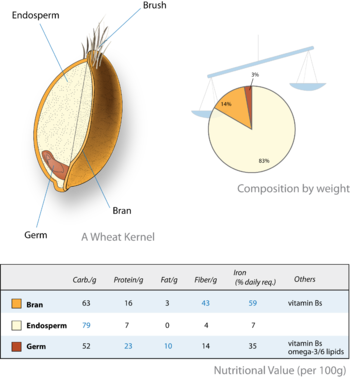Development of endosperm.
Introduction
The endosperm is the tissue formed inside the seeds of most angiosperms following fertilization. The endosperm is triploid in most species of flowering plants and surrounds the embryo.

Functions.
It surrounds the embryo, thus providing nutrition in the form of starch. It may also contain oils and proteins which can be used in animal nutrition. For instance, the endosperm in wheat can be ground into flour for the production of bread while barley endosperm is a source of sugar used in beer manufacturing. In some plants such as the coconut, it forms the bulk of the edible part and its water that is nutritious and can also be used to produce beer.
Double fertilization.
The endosperm is formed when two male gametes inside a pollen grain travel into the interior of a single female gametophyte/embryo sac. One of the male gametes fertilizes the egg cell; hence, a zygote is formed while the other male gamete fuses with the binucleate central cell, thus creating a primary endosperm cell. Due to this process of double fertilization, a cell is formed that develops into the endosperm.
Most of the angiosperms, about 70
A particular species of angiosperms called Nupharpolysepalhas a diploid endosperm a result of the fusion of a pollen nucleus with one of the maternal nuclei.
Endosperm formation.
This process has three types of endosperm development as follows:
- Cellular endosperm formation– here a cell wall formation occurs coincidentally with the nuclear divisions. For example, the coconut meat is a cellular endosperm.
- Nuclear endosperm formation– free nuclear divisions take place repeatedly e.g., coconut water.
- Helobial endosperm formation– where one half develops endosperm along cellular pattern while the other half along the nuclear pattern.
Development of embryo.
Embryogenesis is the process that occurs after fertilization of the ovule to form a fully developed embryo. The resultant zygote undergoes several cellular divisions and differentiation to form a mature embryo. The final embryo has five major components namely;
- Meristem
- Hypocotyl
- Root meristem
- Root cap
- Cotyledons
Morphogenic events.
Natural embryogenesis occurs as a result of single or double fertilization. This gives rise to two distinct plant structures, namely the plant embryo and endosperm which go on to develop into a seed. The events of morphogenesis form a basic cellular pattern for the development of the primary tissue layers and the shoot root body.
Maturation.
Postembryonic development includes the maturation of cells leading to cell growth and storage of macro molecules necessary as food and energy supply during germination.